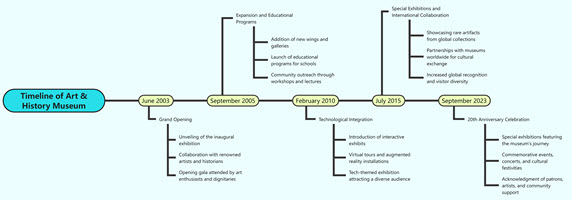Timelines are versatile tools used across various disciplines to visually represent chronological sequences of events. They provide a comprehensive overview of historical, project-based, or personal developments, making complex information more accessible and understandable.
Educational Tools in History
In historical contexts, timelines serve as powerful educational aids. They enable students and enthusiasts to grasp the order and significance of key events. By illustrating when events occurred, timelines help learners connect historical dots, fostering a deeper understanding of the past. This visual representation encourages engagement and retention, making history more relatable.
Project Management Essentials
Project managers frequently utilize timelines to outline project milestones, deadlines, and dependencies. This practice facilitates efficient planning and execution by providing a clear visual roadmap. Timelines help teams stay on track, ensuring that everyone understands their roles and responsibilities within the project’s timeline. They also allow for better communication with stakeholders, who can quickly see progress and upcoming tasks.
Strategic Business Planning
In the business world, timelines aid in strategic planning. They showcase the evolution of products, company milestones, or market trends, allowing organizations to visualize their growth trajectory. By mapping out critical events, businesses can identify patterns, anticipate challenges, and make informed decisions about future initiatives. This structured approach to representing time-sensitive data is invaluable for strategic planning and analysis.
Personal Storytelling
Timelines also play a vital role in personal storytelling. Individuals can utilize them to outline career progress, highlight significant life events, and showcase achievements over time. Whether crafting a professional resume or documenting educational milestones, timelines provide a compelling way to present a chronological sequence of personal developments. This visual representation not only offers a snapshot of one’s history but also serves as a dynamic storytelling device.
The Art of Reflection and Goal Setting
Creating a personal timeline enables individuals to reflect on their past, set future goals, and communicate their unique narrative in a concise and engaging manner. This tool is versatile and impactful for personal expression and self-reflection, allowing individuals to map out their achievements and aspirations visually.
Elevating Timeline Creation with Visual Paradigm Smart Board
Crafting timelines has become more seamless and efficient with the advent of tools like Visual Paradigm Smart Board. This professional and versatile tool is designed to elevate your timeline creation experience.
With a user-friendly interface and robust features, Visual Paradigm Smart Board streamlines the entire process of timeline creation. Whether illustrating project milestones, mapping career progression, or showcasing personal achievements, this tool provides a modern and effective solution.
Embrace the simplicity and power of Visual Paradigm Smart Board to bring your timelines to life in a digital and collaborative space. Here, creativity and efficiency converge, making timeline creation not just easy but also enjoyable.
Timeline Example

The key elements highlighted in the image are:
- Theme: This is the overarching topic or focus of the timeline.
- Start Date: This indicates the beginning point or starting date of the timeline.
- Date: This represents the specific date(s) being highlighted along the timeline.
- Major Event: These are the key occurrences or milestones being displayed on the timeline.
- Event Details: These are the additional details or information provided for each major event.
- End Date: This indicates the concluding point or ending date of the timeline.
The structure of the diagram shows how the timeline progresses chronologically from the start date to the end date, with the major events and their corresponding details nested within. This visual format allows the viewer to quickly grasp the sequence and significance of the events being presented in a clear and organized manner.
The use of this type of timeline diagram can be beneficial across various applications, such as project management, historical analysis, personal development, and more, by providing a concise yet comprehensive representation of information over time.
Case Study – Key Event of a Restaurant
This timeline depicts the key events and milestones in the history of a restaurant. Let’s take a closer look at the details:
Background:
The restaurant appears to be celebrating its 4th anniversary, having opened in April 2018. It has established itself as a local culinary destination, recognized for its innovative dishes and outstanding contributions to the culinary scene.

Timeline of Events:
- April 2018 – Grand Opening: The restaurant celebrated its grand opening, introducing a unique culinary concept to the local community.
- September 2018 – Unveiling Signature Dishes: The restaurant unveiled its signature dishes, delighting its patrons and attracting new customers through live entertainment and promotions.
- May 2020 – Local Culinary Awards: The restaurant received recognition for its culinary excellence, showcasing innovative dishes and outstanding contributions at a local awards ceremony. This increased its visibility and earned positive reviews.
- March 2022 – 4th Anniversary Celebration: To mark its 4th anniversary, the restaurant introduced a special menu, promotional offers, and customer appreciation events. It also recognized loyal customers and staff for their support.
Sustainability and Community Outreach:
In its 4th year, the restaurant has focused on sustainability and community outreach initiatives. These include the introduction of eco-friendly practices, collaboration with local farmers and producers, and the organization of charity events and partnerships with local nonprofits.
This timeline demonstrates the restaurant’s growth, achievements, and commitment to culinary excellence, sustainability, and community engagement over the past four years. The strategic planning and execution of these events have contributed to the restaurant’s success and positive reputation within the local community.
Conclusion
The diverse applications of timelines highlight their importance across various fields. Whether in education, project management, business, or personal storytelling, timelines offer a structured and engaging way to convey information. With tools like Visual Paradigm Smart Board, creating these valuable resources has never been easier, paving the way for clearer communication and more impactful narratives.
Timeline Diagram Templates

Generic Timeline Template

Timeline of NGO Organization

Timeline of Advertising Company

Timeline of University

Timeline of Restaurant

Timeline of Art & History Museum

Timeline of Coffee House

Timeline of Shopping Mall

Timeline of Bar

Timeline of Hospital

Timeline of Celebrated Author
